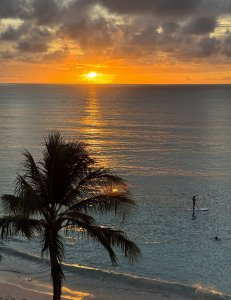Barbados Rum Experience: Part 1
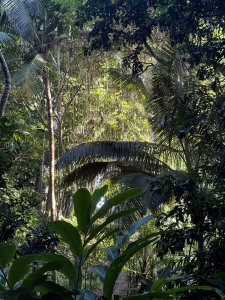
The land falls away as we peer through thick forest to the Atlantic coastline. A few houses on the hillsides. A swathe of royal palms follow a ridge. Look closely and you can discern the tiered uplifts of coral limestone. Unchanged, primeval, thickly wooded and a contrast to the Caribbean coast with its sand, golf courses and hotels. This, you think, is the true Barbados, something which speaks of the ’real’ – its untamed, primal heart.
In reality, all of this is new. Coco Hill Forest was created by hotelier and filmmaker Mahmood Patel in 2014. He turned what was a abandoned sugar plantation into a 53ha regenerative agro-tourism project. Terraces were built to stop erosion, 70 species of tropical fruit trees, herbs, and spices planted, hiking trail laid down.
The motivation? To aim for a degree of self-sufficiency and food security. As he explains, 85% of the money made by hotels leaves the island. They, in turn, are reliant on importing food. Growing coffee, cacao, coconut and herbs offsets this in some way – and moves away from the monoculture of cane.
‘It looks like it has always been here, but we only have one small area of the original forest,’ he says. ‘90% of the cover was cut down when sugar started to arrive.’
Coco Hill is a move to redress an imbalance, a reclamation of not just land, but also a reclamation, or declaration, of identity. Barbados taking control of its destiny.
BREAK
‘This region [the Caribbean] is a space where the modern world was imagined.’ Dr Richard Drayton is Professor of Imperial and Global History at Kings College, London. Born in Guyana, he was brought up in Barbados.
The thoughts of a leading academic is not what you would normally expect on a spirits education trip, but the Barbados Rum Experience isn’t your average event. Yes, there are distillery visits and lovely dinners and plenty to taste, but it is predominantly a forum for speakers, all of whom are from the island, to give context.
All of the elements – history, geology, anthropology, agronomy – which coalesce to make a spirit, in this case Barbadian rum, are here. Those elements which are usually ignored in preference to often warped brand histories. Rum, says the BRE, is more than just a fun drink with pirates and tiki mugs hanging off it.
Drayton’s opening argument is that the Caribbean was the birthplace of capitalism, the cradle of colonisation, with Barbados, as the first sugar colony, at the heart. It is also, he argues, where racism (stereotyping by skin colour) started.
He outlines the progression: ‘Indigenous displacement/extermination, large-scale environmental disruption, coerced labour, long-distance trade integrated to the global economy, (but on its periphery), and structured inequality mediated through race’. It’s high time that rum took all of this on board. Day 1, lecture 1 and it’s clear that this ain’t your standard trip.
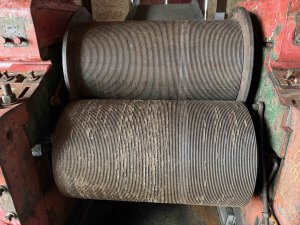
Barbados. A place of migrants and incomers, of exploiters, colonisers, the enslaved, indentured labourers, and political dissenters. The hub, the nexus point for sugar, and therefore rum, in the Caribbean.
As Foursquare’s owner/distiller Richard Seale explains in the first of his two lectures, the transformation from tropical island to sugar colony was rapid.
In the late 1640s, when the Dutch colony in what is now Brazil collapsed, many of its settlers fled north, landing in Barbados. The English had already started to settle there, planting cotton and tobacco. The Dutch, however, brought sugar cane, three-roller mills, windmills … and stills.
What were these early rums like? As Seale lays out, they were made from a mix of cane juice, molasses and skimmings from the boiling pans, the ratio of each varying as the year progressed – more molasses would be used at the end of the year, less at the start.
The expansion of Barbados to sugar colony was rapid and even after the title of largest sugar/rum producer had passed to Jamaica, then Saint-Domingue, and finally Cuba, sugar and rum remained Barbados’ sole industry. It defined the place.
By the mid-19th century consolidation, driven by new technology, was underway. Larger sugar factories, fewer but more extensive estates.
A split emerged between those which only produced sugar and molasses and those which made rum. By 1825, Foursquare itself was one of the former. It closed in 1988 and was bought six years later by the Seales who restarted rum production.
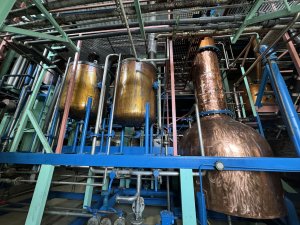
It had been a decade since I’d last been at Foursquare. I knew that things had changed, but not to this extent. What had been a spacious stillhouse with a pot/retort set up and a column still (run under vacuum), was now a seemingly impenetrable mass of copper, and pipework.
There’s now two pot/retort systems, the newest being the first in the world to run under vacuum. This lowers the boiling point, saves energy, and gives greater control over selecting specific flavours.
It was those retorts that I wanted to explore. The day before, Seale had gone into the history of the design and how it was adopted in the Caribbean. Why? Because, he explained, they were more efficient. The range of flavours they can produce were an added bonus. Now distillers can play tuns on them by varying the contents of each of the retorts.
The important point, he added, was that although column stills arrived in Barbados at the start of the 20th century, pots were retained, ‘because they were making expensive quality rum. Blending pot and column is who were are.’
I still had a question about retorts. Now, standing next to them it seemed the right time to ask. It was a mistake. We were in a group. The stills were on. It was hot. Still, I ask him what I thought was a simple question. ‘What do you put in the retorts?’
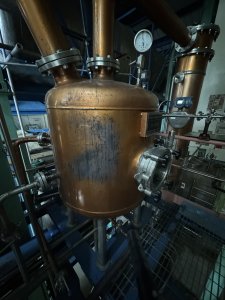
It’s not as daft as it seems. The strength and volume of the liquid in the retort will have a direct impact on flavour. ‘High wines in one,’ he says. ‘Low in the other.’ I nod and make to move off somewhere cooler, but he’s not done.
What follows is a fascinating 10 minute lecture on the liquid and vapour mechanics of a retort. I look up. I’m getting glares from the rest of the party. He continues with his explanation.
We’re both dripping with sweat, the ink in my notebook is running, daggers are stabbing through the back of my soaked shirt. Sometimes you have to suffer for the story. I’ll tell you the details sometime.
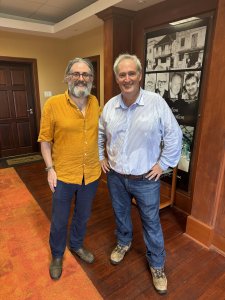
The blending together of higher-strength column, and pot still new rums prior to maturation is key to the Foursquare approach. By changing the ratios of each component, a wider palette of flavours is created.
He cheerily admits he can’t tell what the pot still ratio in any of the flagship Exceptional Cask Selection [ECS] or Maison Velier bottlings is. It’s the sum of the parts that is important.
‘I’m not transparent,’ he’d told me in a previous conversation. ‘I don’t want to be. I want to be authentic and have integrity, but I don’t want to tell you everything because you want to create some mystery. I don’t want to reduce things down to a laundry list of specifications.’
The building of complexity is maintained during maturation. An initial period mostly in ex-Bourbon or ex-Madeira casks – first fill but also refill, then some will go into other types – mostly fortified wine. And The use of Madeira? ‘Do you know how long Madeira has been shipped to Barbados?’ He asks. ‘Since the 17th century!’
There isn’t a standard time for either first or second maturation. Instead, what is happening is a Cognac-like system of élevage, using cask types and fills to build a palette of flavour possibilities and textures. Understanding this and knowing when to change from active to less active casks also allows him to age his rums for longer than had previously been thought possible.
Equidem, the newest ECS, for example, is richly, sweetly concentrated thanks to the use of Black Muscat casks. It’s 14 years old. The whole range – from Doorly’s to the top end is typified by balance, complexity, and elegance. Redolent with ripe tropical and dark fruits, the bittersweet kiss of molasses and balanced oak.
This, then is Barbados.
END OF PART ONE
